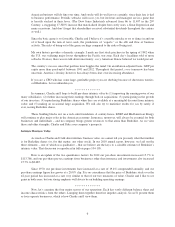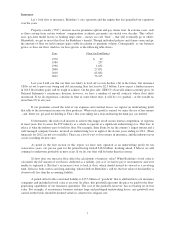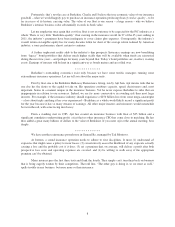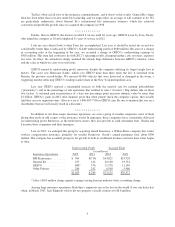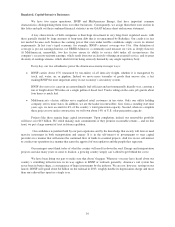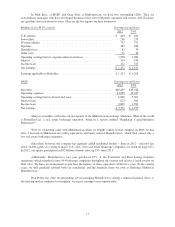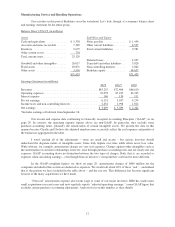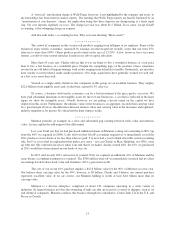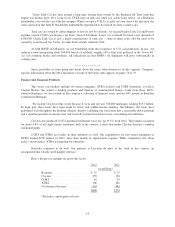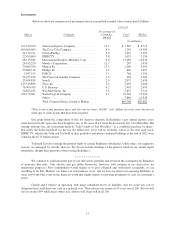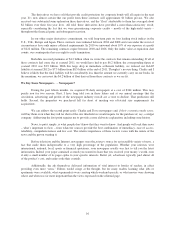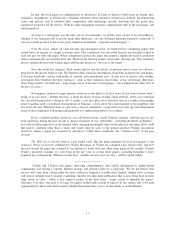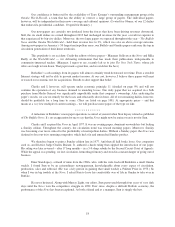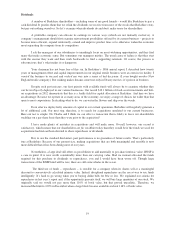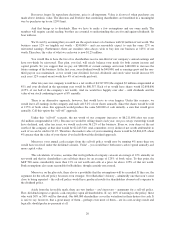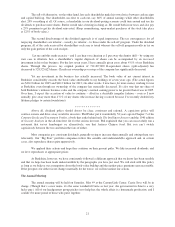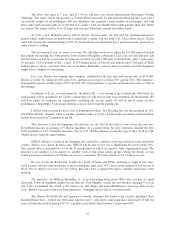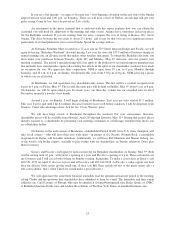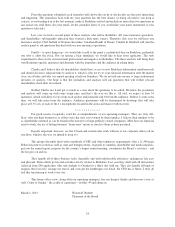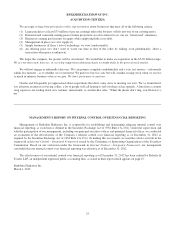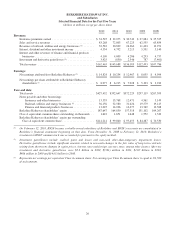Berkshire Hathaway 2012 Annual Report Download - page 18
Download and view the complete annual report
Please find page 18 of the 2012 Berkshire Hathaway annual report below. You can navigate through the pages in the report by either clicking on the pages listed below, or by using the keyword search tool below to find specific information within the annual report.The derivatives we have sold that provide credit protection for corporate bonds will all expire in the next
year. It’s now almost certain that our profit from these contracts will approximate $1 billion pre-tax. We also
received very substantial sums upfront on these derivatives, and the “float” attributable to them has averaged about
$2 billion over their five-year lives. All told, these derivatives have provided a more-than-satisfactory result,
especially considering the fact that we were guaranteeing corporate credits – mostly of the high-yield variety –
throughout the financial panic and subsequent recession.
In our other major derivatives commitment, we sold long-term puts on four leading stock indices in the
U.S., U.K., Europe and Japan. These contracts were initiated between 2004 and 2008 and even under the worst of
circumstances have only minor collateral requirements. In 2010 we unwound about 10% of our exposure at a profit
of $222 million. The remaining contracts expire between 2018 and 2026. Only the index value at expiration date
counts; our counterparties have no right to early termination.
Berkshire received premiums of $4.2 billion when we wrote the contracts that remain outstanding. If all of
these contracts had come due at yearend 2011, we would have had to pay $6.2 billion; the corresponding figure at
yearend 2012 was $3.9 billion. With this large drop in immediate settlement liability, we reduced our GAAP
liability at yearend 2012 to $7.5 billion from $8.5 billion at the end of 2011. Though it’s no sure thing, Charlie and I
believe it likely that the final liability will be considerably less than the amount we currently carry on our books. In
the meantime, we can invest the $4.2 billion of float derived from these contracts as we see fit.
We Buy Some Newspapers . . . Newspapers?
During the past fifteen months, we acquired 28 daily newspapers at a cost of $344 million. This may
puzzle you for two reasons. First, I have long told you in these letters and at our annual meetings that the
circulation, advertising and profits of the newspaper industry overall are certain to decline. That prediction still
holds. Second, the properties we purchased fell far short of meeting our oft-stated size requirements for
acquisitions.
We can address the second point easily. Charlie and I love newspapers and, if their economics make sense,
will buy them even when they fall far short of the size threshold we would require for the purchase of, say, a widget
company. Addressing the first point requires me to provide a more elaborate explanation, including some history.
News, to put it simply, is what people don’t know that they want to know. And people will seek their news
– what’s important to them – from whatever sources provide the best combination of immediacy, ease of access,
reliability, comprehensiveness and low cost. The relative importance of these factors varies with the nature of the
news and the person wanting it.
Before television and the Internet, newspapers were the primary source for an incredible variety of news, a
fact that made them indispensable to a very high percentage of the population. Whether your interests were
international, national, local, sports or financial quotations, your newspaper usually was first to tell you the latest
information. Indeed, your paper contained so much you wanted to learn that you received your money’s worth, even
if only a small number of its pages spoke to your specific interests. Better yet, advertisers typically paid almost all
of the product’s cost, and readers rode their coattails.
Additionally, the ads themselves delivered information of vital interest to hordes of readers, in effect
providing even more “news.” Editors would cringe at the thought, but for many readers learning what jobs or
apartments were available, what supermarkets were carrying which weekend specials, or what movies were showing
where and when was far more important than the views expressed on the editorial page.
16


